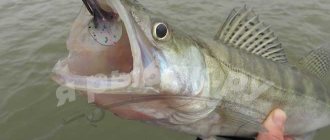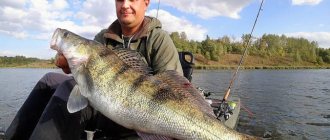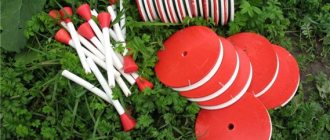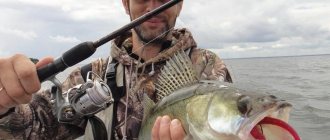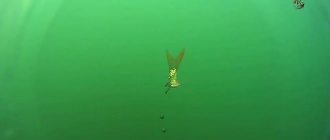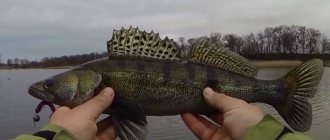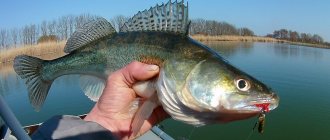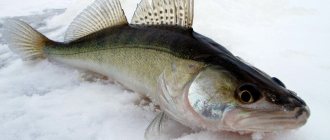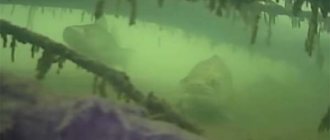When you say that you are going to catch pike perch with mugs, many people shrug their hands in bewilderment. Why put in the effort when the predator “sits” well when working by trolling or other methods. Indeed, catching pike perch with mugs requires a lot of work. You need to choose the time, the appropriate position, and arrange the gear correctly. However, the result will not take long to arrive. Interestingly, fishing with mugs brings more trophy pike perch than other methods of silent hunting for predatory fish.
Setting up circles for catching pike perch
Circles for catching fanged fish are a round disk, the average diameter of which is 150 mm.
The thickness of the disc does not exceed 40 mm. For production, light, relatively strong materials that do not sink in water are used:
- Pine.
- Spruce.
- Linden.
- Expanded polystyrene.
- Dense foam.
Wooden products are treated with waterproof paints and drying oils. The disk must be painted with bright paint: yellow or red paint is applied to the surface part. The underwater part is painted white. To wind the fishing line along the end, you need to make a groove.
Boat and equipment for fishing for pike perch with mugs
Before leaving the shore, you must prepare all the supplies in advance. You need a small boat with oars. At the same time, there must be enough space in the boat to accommodate all the equipment, since fishing with mugs is a technically complex procedure. Every thing should be in its place. A bucket of live bait and cages are next to your feet. The mugs are on the side of the boat. You should not place more than 15 circles, so this amount will be enough. The landing net and spare live bait are located at the back of the boat. You should have an extractor with a hammer at hand.
Necessary equipment
Charged mugs are free floating.
A boat is required for fishing, especially if there is a current. Equipment for pike perch circles:
- Pin. A mast is placed in the center of the structure. This is an ordinary peg made of wood, in the upper part of which there is a cut for fixing the fishing line.
- Fishing line. You can use braided wire, although opinions vary. As for the parameters: line thickness is 0.35-0.4 mm. Line lengths must be kept in reserve. The total length of the fishing line should be 5-10 meters greater than the maximum depth in the intended fishing location.
- Leash. When fishing for pike perch, it is not advisable to use metal leashes. They can serve as an additional irritant for the fanged inhabitant of the depths. A regular fishing line with a diameter of 0.3 mm will be sufficient. A metal leash is installed only for frequent pike attacks.
- Swivel. An important element prevents twisting of the equipment with live bait. Allows you to quickly change the leash with a carabiner.
- Hooks. There are different options here, depending on the fishing conditions and the preferences of the fisherman. More often, doubles are used, which perfectly pierce the bony mouth of pike perch.
Recommended reading: Common loach
Note! The hooks used may vary in size. Live bait is placed on the small one, and the larger one is pressed against the back of the fish, preventing the predator from pricking itself ahead of time.
What do circles represent? Equipment for catching pike perch
For catching predatory fish with live bait using circles, bays or creeks, rivers or lakes with low currents are best suited. Using mugs in fast currents is problematic even with experience.
A circle is a flat disk with a diameter of about 20 cm and a thickness of up to 3-4 cm. It is made of wood, polystyrene foam or polystyrene foam. To prevent the harmful effects of water, the mugs are coated with waterproof drying oils or paints. The color of the circle should be bright so that you can notice its movement. The surface part is painted red or yellow, the underwater part is painted white. To wind the supply of fishing line, a groove is made from the end of the circle. At the very top, which is a peg. The peg is made from softwood. This element can be easily cut with a regular knife. A cut is made in the upper part of the peg and the fishing line is fixed.
To notice the rotation of the circle when biting, the lower part is painted with dark stripes.
Fishing circle
Equipment matters more. It should be invisible in the water and at the same time durable. It is better to use nylon braided or twisted cords as fishing line. Twisted ones need to be soaked in drying oil so that they do not curl.
The length of the fishing line must exceed the maximum depth of the reservoir by 5-6 meters, withstanding a load of 6 kg. This length is needed so that the pike perch, having grabbed the bait, does not feel the resistance of the circle. Winding on circles is carried out only in one direction.
It is better to make a leash from monofilament or wire that is not susceptible to corrosion. The optimal leash length is 30-60 cm. Thickness is half a centimeter (no thicker than the main line). A lead weight weighing 10-20 grams will be enough.
Catching pike perch with circles is carried out with a single hook No. 10 or double hook No. 8. For pike it is better to use triples from No. 5-3. Hooks need to be prepared in advance so as not to waste time while fishing.
But it should be noted that a metal leash for pike perch is not the best idea. Metal is suitable for pike, which are rarely found in pike perch habitats. Moreover, in the summer, pike perch is caught from dawn until breakfast, pike - until lunch. In summer, you need to start catching pike perch with mugs at dawn.
Fishing times and places
The most active pike perch bite in the summer is immediately after sunset (thirty minutes) and an hour after the sun rises.
During the autumn zhora, the fanged can hunt around the clock, taking short breaks.
Ambush sites can include holes, abnormal changes in the bottom of the reservoir, fallen trees and snags.
Note! The fanged fish almost always accompanies schools of bream. We are talking about autumn fish activity. During Indian summer, bream can approach the coastline, where they play in the upper layers of water.
This fact, together with other positions, can serve as a starting point for catching a predator with mugs.
Catching pike perch with live bait using circles will be successful when placing floating traps:
- In the bays.
- On rivers with moderate currents.
- In the lakes.
The use of the gear in question is very problematic on fast rivers. The current creates additional difficulties not only for beginners, but even for experienced anglers.
Choosing a place and time to catch pike perch
Choosing the right fishing location can be more important than knowing the biological characteristics of the fish, having good equipment and a boat. A correct understanding of the topography of a river or lake gives a great chance of a successful catch.
If you will be fishing in an unfamiliar reservoir, check the map before leaving. Maps may show areas where buildings or riverbeds are flooded. Get as much information as possible about your chosen location. You can consult local fishermen. Subtle features of the area can play a greater role in choosing a fish habitat. The databases of fishing societies often indicate the habitats of predators, which can be viewed if desired.
Pike perch chooses wide, clear waters with weak currents. Stones and parking lots that slow down the flow, areas below the water riffles. Other predatory fish also choose such places.
Depending on the time of year and weather, pike perch can change their parking location. Catching pike perch with mugs in the summer is more productive. Pike perch is a schooling fish, and in the summer season it comes closer to the surface. The fact is that in the warm season, small fish that pike perch hunt swim closer to the surface of the water. Using mugs, it is much easier to catch a predator in a school at shallow depths. Fishing with circles in the fall may not be effective. The fish swims to deep places with snags and gorges, where fishing with mugs is more difficult.
Unlike pike, pike perch stay in schools and prefer clean water rich in oxygen
Fishing technique
There is no need to rush to hook: the bait may come out of the mouth.
The fanged one can be found on the edges, in the bottom layers of water: the live bait should be 500-700 mm from the bottom. When fishing for pike perch at night, it is better to use anchor circles when choosing edges.
The leash is fixed at a certain level: 400-600 mm. The live bait is attached to the lip: the sinker goes to the bottom. The free line is wound up and fixed on the pin of the circle.
When a predator attacks, the circle turns over. A white disc appears on the surface of the water. If you use an anchor circle, it is better to use a sinker weighing 200-400 grams.
During zhora, pike perch is active, therefore, its attack is sharp. The circle instantly turns over. There is no need to rush to hook: the bait may come out of the mouth. A pause is necessary during which the fishing line will gradually unwind; during this time the fanged fish can pull off 1.5-3 meters of fishing line. Only then is a sweeping, energetic sweep done.
Recommended reading: How to catch bream on the river in winter
Fishing stages
The main guarantee of a good catch is also a clear distribution of the process, so all actions must be performed in the following sequence:
- First, a place for fishing is selected.
- Then the buoys are placed depending on the depth of the reservoir. To do this, you must always have a depth gauge with you.
- After the buoys are placed, the circles are placed.
- Next, it is best to sail away from the circles at a decent distance and watch the circles.
- As soon as the circle turns over, you need to swim to it from the leeward side and hook the fish.
- Once the fish is caught, it must be killed. A hammer or knife is used for this.
Practical advice
In September, pike perch has a serious competitor - pike.
The predator has favorite ambush and hunting spots. It is advisable to record the place where the bite occurred on GPS.
When catching pike perch, it is better to use live bait that lives in a given pond or river. The fanged one is naturally endowed with an excellent sense of smell and unfamiliar smells can alert him. He will not completely refuse live bait, but the quality and quantity of bites may be greatly reduced.
For short-term fishing, you can use any small fish. If you need to leave the gear for a long time, it is better to use the most tenacious perch as live bait.
When hunting for a predator in a “snagged” reservoir, you need to leave a large supply of fishing line. You must not allow it to completely unwind, otherwise the pike perch may get the tackle under the snag and get confused. The working part of the fishing line is measured based on the depth of the promising location.
Although pike perch prefers to hunt in the lower layers of water, you need to understand that the bottom is an additional obstacle to the equipment. To prevent the live bait from clinging to the bottom, it is raised by 50-70 cm. If there are a lot of snags in the area, it is better to raise the equipment even higher.
When a predator bites, the fishing line that is in the gaps should come off easily without creating tension. Otherwise, the fanged one will sense the catch and spit out the bait. When fishing for a trophy, you shouldn’t take risks; it’s better to use a fishing landing net.
September is characterized by increased activity of the predator, focusing on the weather and water level in the reservoir. You can meet the fanged robber at dawn, in calm water. In September (second half of the month), pike perch has a serious competitor - pike. Many people switch to catching the toothy robber.
If we generalize the fishing period, we can talk about the possible use of circles until the first ice appears.
Finally
Hunting for pike perch on mugs requires careful preparation. It takes a lot of time and physical effort. It's one thing to place fighters in positions. Another thing is to constantly monitor them and move around, raising the disks, checking the bait.
Recommended reading: How to catch pike perch in the fall
But it is movement that creates drive. When you're doing gambling, you don't notice the time that flies by in an instant. We recommend trying the not-yet-massive hunting of fanged animals using discs and live bait. It’s better to go out on the water for the first time accompanied by an experienced assistant.
A little later, we will consider in detail the issue of specific fishing for pike with mugs. Follow the post, good luck!
Autumn mugs for pike perch
To successfully catch pike perch with circles, you need not only to know the zones where they go hunting, but also to correctly build fishing tactics. The feeding time of the “fanged one” is also taken into account. Mugs should be properly equipped and positioned based on predator activity.
Typically, in pike perch fishing, mugs are more effective than spinning rods, but they require a lot of work and patience. If you have chosen the right place for fishing, and the pike perch is active, it will take the bait swimming past it without delay. Several periods of pike perch activity are known. The autumn peak of activity occurs in September-October. At this time, the water had already cooled down enough, small fish gathered in large dense schools and moved to the depths. Here a feeding pike perch awaits her. He can stand on the edge, below or above it. In September-October, it was good to catch pike perch in the deep sections of some reservoirs of the channel named after. Moscow. It often stands here in deep waters near piers and, when active, can hunt for bleak both at the bottom and in higher layers of water. It is important to choose the right fishing tactics and have live bleak in the eland. Moreover, the bleak remains alive for a long time when oxygen is pumped into the eland.
To catch a supply of bleak, fishermen use special devices made of mesh with a fine mesh. Sometimes bleak can be caught with a lift. In the absence of special gear, bleak is caught with a fishing rod, although this process is quite long.
During the hunt, pike perch moves behind schools of small fish. At the beginning of autumn, bleak can move at different depths, and pike perch stays there as well. The installation level of live bait can be only 1-1.5 m, but more often it is deeper. However, it is not always possible to determine where the bleak is concentrated, so when fishing with circles, they are guided by the underwater terrain. Usually, pike perch always stays in the area of dumps, where the depth from 4-6 m can sharply drop to 8-10 m. Therefore, circles lined up in a row or in a certain order are allowed to irrigate perpendicular to the flooded bed. In calm weather, mugs can be placed along the edge of the riverbed or along the edge of a large hole. If there are no bites at the top, you can release live bait at half-water or even place it near the bottom. At the same time, you need to make sure that when passing the mug, the live bait does not cling to the bottom.
In September, pike perch is more often caught in the morning and evening dawns in the area of various edges. At the same time, there is a pattern that in the morning pike perch usually takes it closer to the surface or at mid-water, and in the evening - from the bottom. Sometimes a flock stays along the edge of a hole. When planning to catch pike perch at night, it is necessary to take into account that during a bright moon this predator does not bite well.
They often launch circles at random, constantly moving along the riverbed, since it is not always easy to determine exactly where on the edge the pike perch is standing. In addition, bites can also occur during irrigation at a sufficient distance from the riverbed. When running circles, you need to mark the place where the bites start with special foam buoys. Sometimes small plastic bottles can be used for this purpose.
Boat
It is best to use a light, medium-sized rowing boat (or one equipped with a quiet electric motor). Boats that are too cramped will not be suitable, since fishing with mugs is one of the most technically complex types of fishing and a certain space is required to accommodate all the gear and devices.
You should immediately think about how to place everything in the boat, but in this matter the best help is “experience is the son of difficult mistakes.” Rubber boats can make a lot of noise, which can scare away walleyes.
Mugs for pike perch: equipment
Catching pike perch with mugs is considered the most common and productive way. It is probably almost impossible to meet a fisherman who would not dream of showing off such a trophy as pike perch to relatives and friends. But not everyone knows that it is caught much more readily with mugs than with a spinning rod. Although this option requires much more effort and special preparation of gear. In addition, successful fishing for pike perch directly depends on skill, the presence of at least a small boat, and also proper control of it.
Preparing gear
Mugs
The circle is designed for catching predatory fish with live bait on lakes and rivers with a slow current, and the most preferred places are bays and creeks, since in a fast current, even the most experienced fisherman may not have enough skill to control the boat to “serve” all the circles.
Structurally, the circle is a flat disk with a diameter of approximately 15 cm and a thickness of 25–30 mm. For production, either soft wood species (pine, spruce, linden) or hard foam are used. Naturally, to prevent exposure to water, the mugs are painted with at least two layers of waterproof paints.
The color of the circles plays another important role - it is an indicator of its behavior, which often indicates bites from predatory fish. The lower part is painted white, and the upper part is painted red, which makes the circle visible on the water even in light wave conditions.
A groove about 15 mm deep is made at the end of the circle for winding a supply of fishing line. To fix the fishing line in the circle, small cuts are made on its upper part on diametrically opposite sides.
A peg with a diameter of about 20 mm is inserted into the center of the circle. It is best to fix the peg in the hole using a balsa wood insert.
The peg should have a length at the top approximately equal to the diameter of the disk - that is, 150 mm. The upper part has a cut for fixing the fishing line and is painted in the same color as the disk itself - red or orange.
The lower part, which has a pear-shaped thickening, is painted white, but longitudinal dark stripes are made on it in order to notice from a distance the rotation of the circle when unwinding the fishing line. This most often happens after the fish has grabbed the bait.
Line, leashes, sinkers, hooks
It is preferable to use a braided cord as a fishing line, since it is less springy and will not come off in rings from the circle, which can cause tangling, but it is better to make a leash from monofilament of the same diameter as the cord;
the use of metal leashes is impractical: they only scare away pike perch and interfere with the play of live bait. The length of the cord (fishing line) wound around the circle should exceed the expected fishing depth by 6–8 meters. This will allow the predator to grab and swallow the prey without feeling the resistance of the circle, because it is this that can cause the pike perch to simply spit out the bait.
The length of the leash is 40–60 cm; it is better to attach it to the main cord (line) through a carabiner with a swivel, which will ensure free movement of the bait. It is better to use a weight in the form of an olive weighing 9–15 grams; you can fix it on the fishing line using a bead.
Are you interested in a fishing muzzle?
Our article will tell you this. In this article we will talk about the cost of a fishing license.
To catch pike perch with circles, it is best to use single hooks No. 9–13, double or triple hooks No. 5–9. It is better to attach the hooks to the fishing line using a winding ring with a diameter of 4–5 mm, which will allow you to quickly change hooks and will facilitate the free movement of baitfish.
It is better to prepare leashes with hooks in advance, winding them on a reel, so that when fishing you can fully concentrate on the fishing process itself and not be distracted by making gear.
pike perch biting time
It is believed that the peak summer feeding activity of pike perch is half an hour after sunset and an hour before sunrise. But during the period of bleak hunting, pike perch can be caught with varying success throughout the day. In late summer and autumn, pike perch sometimes go out hunting in the middle of the day, but it is usually short-lived. At the same time, in the area of the edges (and not only), pike perch can periodically hunt either near the very bottom (then live bait is placed 50–70 cm from the bottom), or in the water column. In addition, pike perch can be active at night. At night it is better to place moored mugs, placing them in the area of the edges. The equipment of the moored circle is shown in Fig. 3. Before “loading” such a circle, you need to set the leash lock to the appropriate fishing level (usually 40–60 cm), then securely attach the live bait to the upper palate and lower the sinker to the bottom. Having wound the free part of the fishing line, it is necessary to insert it into the slot so that the main fishing line remains in a tense position under the weight of the load. When bitten, the disk turns over and the bottom (white) side is on top; the fish pulls on the leash, and it, sliding freely along the main line, causes the circle to unwind. Typically, an end weight of 200–300 g is used for a moored circle.
Necessary equipment for fishing
Before you go fishing for pike perch, you must carefully select and prepare all the accessories and take care of the required number of equipment.
For this type of fishing you need to have the following equipment:
- small boat;
- a bucket of live bait;
- cages;
- mugs;
- extractor;
- hammer.
All these accessories must be located clearly in a certain place, only in this case there will be enough space for everything.
Methods for catching pike perch in summer: equipment equipment
There are two main ways to catch pike perch in the summer. This is fishing with a spinning rod and fishing with live bait equipped with float tackle or its equivalent. Each of these methods provides a lot of nuances and features.
Spinning
The main spinning bait for pike perch is a jig bait. This is a silicone twister (in common parlance, a hoof), a vibrotail, or silicone copies of frogs and river worms. The equipment is a regular jig head on the main line, equipped with a silicone bait. Experience shows that pike perch most often prefer light green or white silicone. The wiring should be uniform or stepped.
Uniform wiring is effective in the summer, when the hunter is hyperactive. The predator consistently mistakes the bait for a real fish and attacks it. Stepped retrieving involves short pauses in reeling in the cord or fishing line, during which the bait freezes in the water column and begins to smoothly fall down under the influence of its own weight.
It is at this moment that the attack, the so-called “strike,” occurs. The more sensitive the spinning rod, the better the angler feels the “blow” in the hand, and makes the hook in time. The Dropshot fishing technique is little known among anglers. It is very effective for catching pike perch when it is inactive. This is the period of late autumn-early winter. The equipment consists of a sinker at the end of the main fishing line, 45 cm above which, on a leash, a hook with silicone bait is attached.
No wiring required. A short cast is made, with the spinning rod making progressive movements up and down, with short pauses. The sinker sinks to the bottom, but due to the difference in weight, the silicone fish moves smoothly down, hanging in the water column. Usually at this moment the pike perch attacks the bait.
also work well in the summer ; these are artificial fish made from wood. The materials mainly used are balsa and cedar. This bait behaves very realistically when retrieved and practically does not differ from the real one in its behavior in the water. For catching river robber, sinking and medium buoyancy wobblers are optimal.
Poppers practically don't work. The most effective wobblers are brands such as Rapala and UgglyDuckling. In some cases, Chinese fakes are in no way inferior to them, but are much cheaper in price.
Fishing with live bait
Spinning is the main method of hunting for pike perch. But what to do if you don’t have a spinning rod and appropriate bait at hand. An ordinary float rod or carp rod will do just fine.
In this case, the bait is a real fish - live bait. It is advisable to use live bait from those species of ichthyofauna that live directly in the reservoir where fishing takes place. This is due to the fact that the predator gets used to a certain food supply and changes it extremely rarely.
Live bait is always present in the bycatch during the main fishing for white fish. If there is no such bycatch, then you should worry about buying live bait in advance. Almost any body of water contains so-called “trash fish”. These are bleak, roach, goby, gudgeon, and small rudd. Representatives of these species fully satisfy the requirements of live bait.
Pike perch loves deep holes, so if you are using a float rod, it is advisable to use equipment for long casting. Using a float, you should determine the deepest accessible places and cast directly into these areas of the reservoir. Live bait can be attached to a hook in three ways.
The most common method is to attach the dorsal fin. As a hook, the best option would be a triple or double version. Other inhabitants of the reservoir that are present in the food supply of local pike perch can also be used as live bait. These can be larvae of aquatic insects, crayfish, lamprey larvae, or sandworms. As with spinning fishing, it is also possible to use their silicone versions. The size of the hook is determined by the size of the potential catch.
Rubber
The elastic tackle is popular among beginners. It consists of a main fishing line with leads, which is attached to a piece of round model rubber with a sinker at the end. Hooks with bait are tied to leashes 15-25 cm long.
The fisherman fixes the extreme edge of the fishing line in his hand and, with a spin, casts the sinker into the pond. After that, live bait is placed on the hooks and the stretched rubber is smoothly released until the tension is almost completely relaxed. The installed tackle forms an angle in the thickness of the water, where the outermost hook with bait is located closer to the bottom, and the upper one is closer to the shore-surface.
From 6 to 12 hooks are placed on such tackle. The bait for pike perch is the same live bait. It should be remembered that this gear is prohibited on paid reservoirs, and it cannot be used during the spawning period.
Plumb
If there are moorings for yachts or ferries on the reservoir, you can try to catch pike perch by vertical fishing. Pile structures and lined sections of the shore are also suitable for such fishing. The best option for such fishing would be to have a boat and an echo sounder.
Using the active search method, it is worth looking with an echo sounder for the deepest holes and edges in the reservoir. Pike-perch is a regular in such shelters; this is the best ambush. For vertical fishing you will need a rod with a weight of 30-40 g, it should be as light as possible. It is better to use an inertia-free reel; a multiplier reel will not work in this case.
The method of presenting bait is very similar to dropshot, with the only difference being that the bait itself serves as the sinker. Translational movements up and down alternate with pauses for the bait to fall to the bottom. The bait is a silicone fish, as with the wire fishing method. The attack also occurs when the bait falls in the water column.
For mugs
A passive method of hunting pike perch includes fishing with mugs. The tackle is a disk with a hole in the middle and a groove for fishing line along the edge, a specially shaped pin for this hole, and the equipment itself: hook, line and sinker.
The disc can be made from any buoyant material, such as foam or wood. The bait is live bait. The hook can be either triple or single. The length of the lowered fishing line is arbitrary, depending on the fishing conditions and the depth of the reservoir. The equipped circle starts swimming freely on the surface of the water with baited bait.
It can move under the influence of wind or current. The bite signal is the turning of the circle with the upper end of the pin into the water under the influence of the caught fish. Its underwater end is brightly colored. When it is above the surface of the water, an angler on a boat comes up and takes the catch.
To the girders
Contrary to popular belief, you can catch predatory fish on a girder not only in winter. The design of the summer version is significantly different. The main part of the structure is a wooden slingshot with a length of 13 to 17 cm. The bark should not be removed from it, it will help disguise the tackle. Splits are made at both ends of the slingshot, and a hole is made at its base.
A thick fishing line up to 15 meters long is threaded into the hole. This line is then wound onto the roguline using a figure-of-eight method. The free end with a leash and hook is secured in the slot and lowered into the water. The slingshot is suspended from a tree standing above the water, or from a pin stuck into the bottom. The bait is live bait.
After the bite, the caught fish begins to unwind the fishing line, tearing it out of the slot. But it is not possible to swim further than the length of the fishing line. The slingshot is removed from the pin, and the predator is pulled out by the fishing line. In summer, this method of catching pike perch is extremely rare, since it is quite rare to find sufficiently deep coastal places; it is more suitable for catching pike.
How to anchor mugs for pike fishing
Fast anchoring
Quick anchoring of pinless circles (square and rectangle) is carried out in a matter of seconds. The line is released from the circle, as from the spool of a spinning reel. Its length should exceed the depth of the reservoir at the fishing site by 1.5 m. If at the time of installation of the circles the boat is being carried by a strong wind, then the depth of descent is determined by the readings of the echo sounder. The weight of the load - olives should be 10-12 g. The length of the leash is 0.7 - 0.8 m. The diameter of the leash is the same as that of the main fishing line. The circles are installed in such a way that the wind drags them towards the underwater hill (Diagram 1). The weight of the olive is enough to hold the circle in place even in very strong winds. The fishing line does not spontaneously slip out of the slot even when “white lambs” are walking along the pond. At the same time, the tackle is very sensitive and does not provide resistance to the predator at the moment of grip. When fishing from the bottom (the olive lies on the ground), pike perch bites are observed twice as many.
Anchoring on peat bogs
In shallow peat bogs, where the layer of silt reaches several meters, for anchoring, not one, but two weights are lowered to the bottom - olives, which in turn are locked with swivels (Diagram 2). The distance between the loads should be 1.5 - 2 m. A leash is attached to the second swivel. The length of the leash is at least 0.7 meters. To raise the leash from the bottom and isolate the live bait from the silt, one or 2 mini-floats are fixed on it. As a result, the leash with live bait is located almost vertically. The live bait is attached to a single hook from below, behind the belly closer to the tail. With this method of baiting, when the predator grabs, the hook ends up deep in its mouth. This method of anchoring is more effective than classic anchors, the installation of which takes a lot of effort and time from the fisherman, and is relevant at a depth of 0.5 to 10 m.
Stationary anchoring in rivers or in the wind
For stationary anchoring, a hole is drilled in the corner of a circle or rectangle.
A fishing line is tied through the hole, the other end of which is tied to a signal buoy. The buoy is anchored in the required place, the weight of the anchor depends on the strength of the current or wind. Its task is to hold the buoy and circle in place. The distance between the buoy and the circle should exceed the depth of descent by 1.5 m (Diagram 3). The equipment of the mug is classic, the fishing line is fixed in the slot in a standard way and is released from it when bitten. Next, the circle turns over, as usual, and the fishing line is unwound by the predator. The weight of the olive weight on the mug depends on the strength of the current, the main thing is that it is not squeezed to the surface. The usual weight of the load that holds the buoy when anchoring in the wind in still water is 30-40 g.
Of course, this load will not be able to prevent a predator from stealing the tackle, but this already depends on the attentiveness of the fisherman. The weight of the weight holding the buoy in the current is 0.8 - 2.0 kg. It all depends on the strength of the current. The best circle for anchoring in rivers is a rectangle. In autumn, when the wind blows constantly (its direction does not matter), stationary anchoring of a circle is used when fishing in enclosed reservoirs, especially when the predator is full, and its bites are observed no more than twice a day (Scheme 4).
The article was published in the magazine “Fishing in Rus'”
Source
Workplace
For racing, a circle swimmer needs a spacious rowing boat with good speed and stability on the waves. Inflatable boats, with the exception of a few models, are of little use, since they are slow-moving and have a high windage. In addition, far from the coast they are unsafe for the life of the owner himself. They can be used when chasing pike somewhere in shallow bays of reservoirs or on small lakes, but only in the summer during warm times and near the coast.
The circler’s arsenal in a rigid keel boat is located as follows: at the feet of the fisherman sitting on the oars, a “stable” is installed along the bottom, on both sides of which prepared circles are placed, for example, five pieces on each side; Everything unnecessary that is not involved in the fishing process (jacket, backpack, etc.) is placed on the feed can. An eland is placed behind the back with a supply of live bait and a net floating in it on a foam handle. In the bow of the boat, a rod with a disassembled “spider” of the lift and landing net is placed along the sides. The depth gauge and buoys should always be at hand, that is, to the right or left of the angler. When moving along the line, when the boat mostly moves stern first, since it is more convenient to swim up to the invert and observe the water area, the kukan with the caught fish is secured on the bow of the boat, but after the end of fishing, heading to the shore or to another sink, it stands
